Turning Habits Into Health: How 1 Step At A Time Can Make The Change
TURNING HABITS INTO HEALTH: HOW 1 STEP AT A TIME CAN MAKE THE CHANGE (ISSUE 63)
By Diane Gold
Turning Habits Into Health is just another way of saying we are committing to nurturing ourselves and matching our behaviors with our current goals and game plan.
 Habits, as we know if we think about them, are patterns of behavior reinforced through repetition until they are almost involuntary action. Here’s a short list of these responses: eating oily, salty or sugary snacks to satisfy a food craving; verbally reacting to a child because that’s how we were raised; using mind/body-altering substances (prescribed or not) because we are tired, bored, nervous or emotional; shutting down our emotions because it’s safer than experiencing pain; acting out anger when someone challenges us; eating processed, unhealthy foods to escape; meditating before breakfast; brushing our teeth; taking our shoes off before we enter a residence; swimming after work; praying
Habits, as we know if we think about them, are patterns of behavior reinforced through repetition until they are almost involuntary action. Here’s a short list of these responses: eating oily, salty or sugary snacks to satisfy a food craving; verbally reacting to a child because that’s how we were raised; using mind/body-altering substances (prescribed or not) because we are tired, bored, nervous or emotional; shutting down our emotions because it’s safer than experiencing pain; acting out anger when someone challenges us; eating processed, unhealthy foods to escape; meditating before breakfast; brushing our teeth; taking our shoes off before we enter a residence; swimming after work; praying
before eating.
Obviously, diverse behaviors serve us at various times in our lives. Most of the time, we aren’t even aware these habits are developing. And, usually, we don’t focus on them until our body, mind or spirit call out in despair. Weighing too much signals that our bodies are imbalanced. Pain in our teeth makes us examine our oral hygiene and diet. Emotional over-reaction makes us look at our stability. Our comfort level with the questions of our position in the universe arouses our spirit and calls for grand examination.
 Because we are all so universally tied to habits and we all have them, WarriorsOfWeight.com now honors moms, daughters, fathers, sons, teen girls, teen boys, grandparents in focusing on and educating about Turning Habits Into Health and discussing all the astounding techniques to help each one of us along the way.
Because we are all so universally tied to habits and we all have them, WarriorsOfWeight.com now honors moms, daughters, fathers, sons, teen girls, teen boys, grandparents in focusing on and educating about Turning Habits Into Health and discussing all the astounding techniques to help each one of us along the way.
 Whether we speak about personal development techniques like tai chi, free dance techniques, music and its effects on balance, involvement in social change to get us personally where we want to be or the science of proper nutrition to maximize our bodies;
Whether we speak about personal development techniques like tai chi, free dance techniques, music and its effects on balance, involvement in social change to get us personally where we want to be or the science of proper nutrition to maximize our bodies;
WarriorsOfWeight.com aims to share material for all our supporters. From now on, our new tag line is (drum roll, please)
 Turning Habits Into Health!
Turning Habits Into Health!
And we are focusing on solutions for all of us.
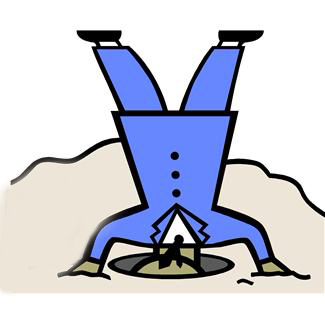 So what are the ways to make this miraculous change in habit? Do we have to turn ourselves inside out?
So what are the ways to make this miraculous change in habit? Do we have to turn ourselves inside out?
The answer, of course, is no. The prospect of making the change may seem as if we have to climb a mountain. The actual journey, if approached step-by-step, is only as difficult as each individual step.
ACTION STEPS

1) Step 1 is to look as far as the first step. The first step is the beginning action step. It’s like the running a race. When we look at 1 more step, and only 1 more step, we get to continue without collapsing – for that 1 step only.
This step could be changing 1 meal to vegetable juice or overcoming the fear of crossing the street or drinking apple juice instead of wine. With all of these habits, there is a first step, the golden step, the one that will begin the habit change.

2) Step 2 is a repetition of step 1 except that we have actual experience doing step 1. We can note that the original habit began because we repeated the same action over and over again.
Therefore, changing the habit is going to require repeating the same action over and over again. Thus, we repeat step 1.
We know we have looked at step 1. We have also looked at step 2. They are the same. So are the next steps.
3) As we get used to this step, we can repeat it more easily each time. If we continue to take the step as a replacement for some negative action that is not supporting our goals, we will begin to replace the habit.
Our journey for change starts out as a cold mountain.

With repetition and confidence, as we begin to get familiarity and control with our new actions, our journey becomes a mountain of joy.
CONCLUSION
We can change a habit with 1 step. It is the way. There is nothing mysterious about it, and the technique is as straight forward as normal breathing. We always have our collection of habits, all of them. Whether we allow them to trigger depends on how well we have replaced them using any means necessary, but usually the 1-step plan.
If we follow each individual step on blind faith, we don’t get distracted with other thoughts. In time, we can take a look at what we’ve accomplished, but not while we are doing it.
ACTION STEPS: THE HABIT CHANGE PROCESS
This section overviews The Habit Change Process. The “snack” habit is chosen so that we can act out the process without getting stuck on which habit to change. The method of 1 step, then repetition of the same step, then repetition of the same step again and again can be used for all habits.
OBJECTIVE
Replacing 1 snack a day with healthy food instead of cookies, chips, soda, anything else. (If you only eat raw food, have an allergy to 1 of the foods; please substitute. If you don’t usually have a snack, please add it for 21 days, just to be part of this process.)
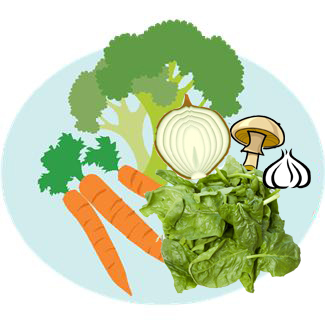 1) Buy veggies (the culinary term “veggies” which would include mushrooms): carrots, broccoli, onions, garlic, spinach, mushrooms.
1) Buy veggies (the culinary term “veggies” which would include mushrooms): carrots, broccoli, onions, garlic, spinach, mushrooms.
2) 5 minutes ahead of the broccoli, steam sliced carrots. Then add broccoli and steam for another 7-10 minutes.
3) In another pot, use some water to brown sliced mushrooms, re-adding water several times as needed. so they don’t burn.
4) Once the steaming is complete, in a wok or saucepan, heat a small amount of olive oil, add garlic to cook, 30 seconds later, add onions.
5) In a couple minutes, add mushrooms, steamed carrots and broccoli.
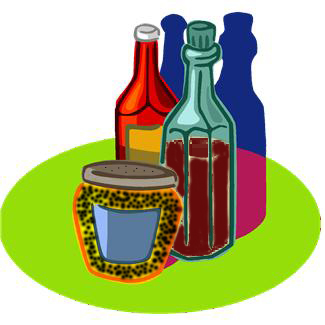 6) Add low-sodium soy sauce or amino acid liquid, a few drops of sesame oil, black pepper, rice vinegar, if you like.
6) Add low-sodium soy sauce or amino acid liquid, a few drops of sesame oil, black pepper, rice vinegar, if you like.
7) Stir fry until everything is tender.
8) Add spinach for 30 seconds.
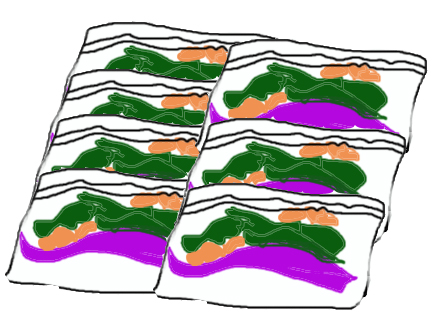 9) Remove from the stove.
9) Remove from the stove.
10) When cool, separate into 7 snack bags, 1 for each day of the week.
11) Refrigerate.
12) Now, you have a mid-afternoon snack for the next 7 days.
13) Set a phone/computer/clock alarm to facilitate this snack.
14) Do this for 7 days.
15) Repeat 1) through 14) for 2 additional weeks in a row.
16) Congratulations. You have gone through the steps to change a habit. Keep it up, and it is changed.
17) Grab your certificate below!

FEEDBACK
Please leave a comment and LIKE.
DIANE GOLD, AUTHOR
Diane Gold, Founder of Warriors of Weight, Turning Habits Into Health, is a mentor in tai chi, kung fu and meditation, a music, fitness and stress expert, dedicated mom, studying plant-based nutrition.
She is more excited about the idea of looking at 1-step until that 1 step is completed. She says,
“When the mind is focused on 1 thing, it is not focused on 2 things. Of course, we need to do a physical act to make the concentration happen, as opposed to intellectually thinking about it.
“When we want to take a step for our betterment, whatever it is, if we focus our attention only on this 1 step; we are less distracted. Imagine walking a tight rope, for example. Because the risk is so great that we would become injured with less than 100% concentration, we concentrate.
“If we don’t take the same care with changing a habit, we can get off track. Easily. So, concentrate on the physical action we have decided would be in our best interest. And we will be happy with the results.”

 Did you know that a huge amount of our world population does not have enough water or has to walk to get it? According to Kathleen Parker’s article, quoting Charles Fishman’s The Big Thirst (on my pending reading list), we, Westerners, use 18.5 gallons a day flushing our toilets while there is only 1/100th of 2.5 percent fresh water on the planet or, if the oceans were broken down into mass, 2.5% of the Earth’s mass. Not a lot.
Did you know that a huge amount of our world population does not have enough water or has to walk to get it? According to Kathleen Parker’s article, quoting Charles Fishman’s The Big Thirst (on my pending reading list), we, Westerners, use 18.5 gallons a day flushing our toilets while there is only 1/100th of 2.5 percent fresh water on the planet or, if the oceans were broken down into mass, 2.5% of the Earth’s mass. Not a lot.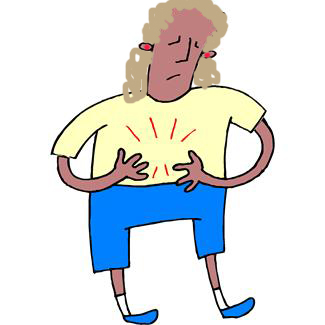 Let’s look at what happens when we start to feel the twinges of hunger. These urges might be immediately after eating, 10 minutes after eating, an hour after, 3 hours apart or more. The amount of time between cravings is a non-judgmental number. The craving begins as an itch, which shows up when it shows up. If we don’t judge ourselves, we won’t be judged! Its intensity determines the level of self-control we need to master it.
Let’s look at what happens when we start to feel the twinges of hunger. These urges might be immediately after eating, 10 minutes after eating, an hour after, 3 hours apart or more. The amount of time between cravings is a non-judgmental number. The craving begins as an itch, which shows up when it shows up. If we don’t judge ourselves, we won’t be judged! Its intensity determines the level of self-control we need to master it. 3)
3)
 After we begin, it will be get much easier for us to recognize and acknowledge it when we have a food urge. Whereas before, we might have felt we had to sneak to eat, we will no longer have to sneak, since our first line of food defense can be healthy, wonderful water. Whereas before, we might have felt guilty for eating mindlessly, we can feel pride because we are eating as part of a technique.
After we begin, it will be get much easier for us to recognize and acknowledge it when we have a food urge. Whereas before, we might have felt we had to sneak to eat, we will no longer have to sneak, since our first line of food defense can be healthy, wonderful water. Whereas before, we might have felt guilty for eating mindlessly, we can feel pride because we are eating as part of a technique.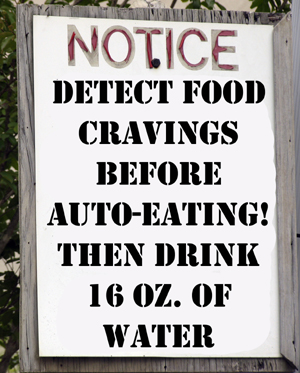 The act of making change takes time and effort. That includes water for weight loss. The biggest effort is in training the mind (changing a habit) that when we have a food craving, we need to embrace it. We need to drink 16 oz. of water, slowly. This is great in theory, but…
The act of making change takes time and effort. That includes water for weight loss. The biggest effort is in training the mind (changing a habit) that when we have a food craving, we need to embrace it. We need to drink 16 oz. of water, slowly. This is great in theory, but…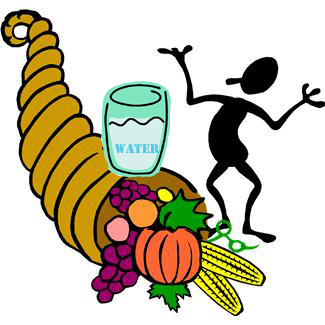 For those of us in the United States and some other countries, we can be extra thankful that we do have water readily available. 2/3 of world families do not (National Geographic Society Geography Awareness Week, 2010). They have to walk to get their water; they have to transport it on shoulders, backs or holding buckets.
For those of us in the United States and some other countries, we can be extra thankful that we do have water readily available. 2/3 of world families do not (National Geographic Society Geography Awareness Week, 2010). They have to walk to get their water; they have to transport it on shoulders, backs or holding buckets.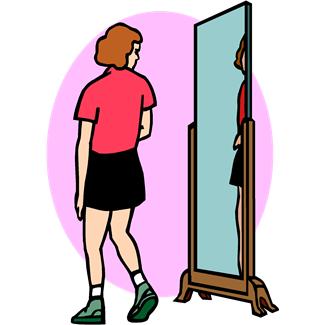 Before we talk about food cravings and how to maximize them for health, I’d like to say that this article is about FAITH, not faith in someone or something else, but faith in ourselves that we may not be able to see yet. It is similar to that faith that many people attribute to a supreme entity; yet, we are going to use faith in ourselves for this lesson.
Before we talk about food cravings and how to maximize them for health, I’d like to say that this article is about FAITH, not faith in someone or something else, but faith in ourselves that we may not be able to see yet. It is similar to that faith that many people attribute to a supreme entity; yet, we are going to use faith in ourselves for this lesson. 4) We are risk takers, and, like the casino gambler, we bet that eating healthier foods and amounts tomorrow is reason enough for us to gamble with our health and maintain our same habits now.
4) We are risk takers, and, like the casino gambler, we bet that eating healthier foods and amounts tomorrow is reason enough for us to gamble with our health and maintain our same habits now. Think of a band member who is playing the wrong note because she has gotten used to playing that particular note and even enjoys how it sounds. When her band leader corrects her, she will have to change her habit to balance the group. In order to keep her job and continue playing the music that she loves, she will make the change.
Think of a band member who is playing the wrong note because she has gotten used to playing that particular note and even enjoys how it sounds. When her band leader corrects her, she will have to change her habit to balance the group. In order to keep her job and continue playing the music that she loves, she will make the change.
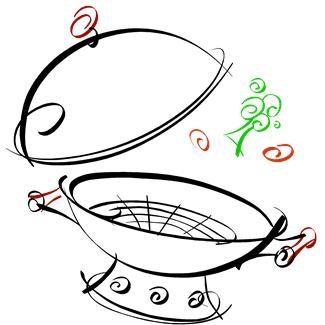 2)
2)  Microwave ovens rob nutrients from our food, and stoves take longer than our craving will wait. Eventually, when we have changed our habit from “cue to instant eating” to “cue to patience to eating healthily,” warming our veggies may be an option.
Microwave ovens rob nutrients from our food, and stoves take longer than our craving will wait. Eventually, when we have changed our habit from “cue to instant eating” to “cue to patience to eating healthily,” warming our veggies may be an option. There is much evidence that plant-based nutrition helps rid us of a variety of modern-day ailments. However, major “Western” food manufacturers downplay it. After all, what would happen to their food consumption if even 50% of the people who now eat meat/fish/fowl/dairy/eggs changed their ways?. What would manufacturers do if people in the United States stopped eating processed foods?
There is much evidence that plant-based nutrition helps rid us of a variety of modern-day ailments. However, major “Western” food manufacturers downplay it. After all, what would happen to their food consumption if even 50% of the people who now eat meat/fish/fowl/dairy/eggs changed their ways?. What would manufacturers do if people in the United States stopped eating processed foods?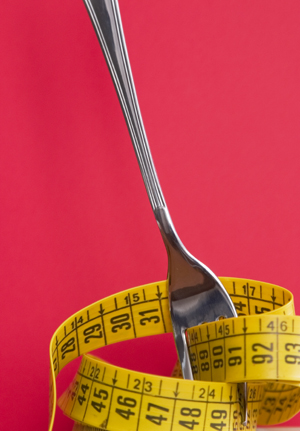
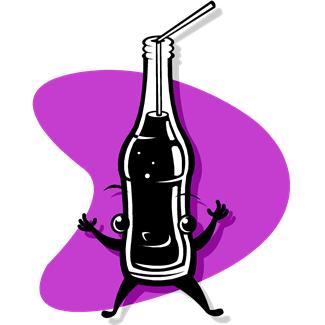 Let’s look at soda, including diet-soda. The highest source of calories of any food in the United States is soda. It is an acid-forming food along with diet soda, which has no calories but is in the same acid category. Both regular and diet soda contain phosphoric acid, all the way over on the acid side of acid-forming foods.
Let’s look at soda, including diet-soda. The highest source of calories of any food in the United States is soda. It is an acid-forming food along with diet soda, which has no calories but is in the same acid category. Both regular and diet soda contain phosphoric acid, all the way over on the acid side of acid-forming foods.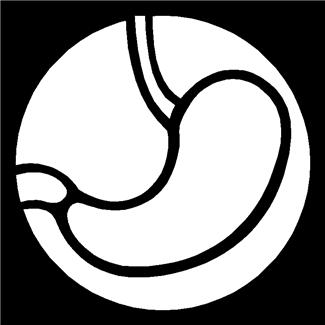 Did you know that saliva is alkaline and that if you chew more, you enable the digestive process? Many monks profess that we chew our food 50 times before swallowing. This will predigest the food and liquify it. It will provide a time for us to appreciate the food without rushing. Now, I know it will certainly combine well with alkaline saliva for body health.
Did you know that saliva is alkaline and that if you chew more, you enable the digestive process? Many monks profess that we chew our food 50 times before swallowing. This will predigest the food and liquify it. It will provide a time for us to appreciate the food without rushing. Now, I know it will certainly combine well with alkaline saliva for body health.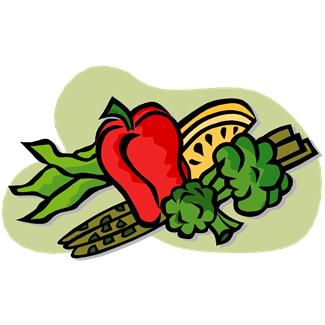 Feel good, feel balanced. Consider eating plant-based nutrition for a proper pH level. Keep the body in the best position for losing weight, and learn which foods are alkaline and eat them.
Feel good, feel balanced. Consider eating plant-based nutrition for a proper pH level. Keep the body in the best position for losing weight, and learn which foods are alkaline and eat them.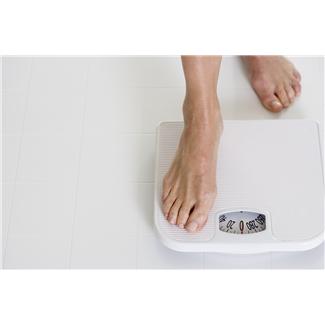 The weight loss goal is huge because it relates to almost every aspect of our everyday lives. Often times, we have to change many behaviors of our eating process in order to change 1: the way we move, the way we rest and the restaurant or food preparation routines we have grown to love.
The weight loss goal is huge because it relates to almost every aspect of our everyday lives. Often times, we have to change many behaviors of our eating process in order to change 1: the way we move, the way we rest and the restaurant or food preparation routines we have grown to love. I know it always takes me a few minutes to process the possibility of change, a few minutes to get used to the idea and another several minutes to accept the change. This usually takes a good 30 minutes. It’s very comforting to watch myself through this process. I usually laugh at myself during it, as I am so predictable to myself. Luckily for me, because of my mother’s bright attitude and the practicality for which my martial arts work has prepared me, I always, and I mean always, end up looking for the good in the crossroads.
I know it always takes me a few minutes to process the possibility of change, a few minutes to get used to the idea and another several minutes to accept the change. This usually takes a good 30 minutes. It’s very comforting to watch myself through this process. I usually laugh at myself during it, as I am so predictable to myself. Luckily for me, because of my mother’s bright attitude and the practicality for which my martial arts work has prepared me, I always, and I mean always, end up looking for the good in the crossroads. 1) We can rebel and stomp our feet at our new situation. If we turn music on and stomp to it, we can turn our reaction into a totally therapeutic action. Verbalizing to the music helps us to accept the change, too, as is done in improv or rap.
1) We can rebel and stomp our feet at our new situation. If we turn music on and stomp to it, we can turn our reaction into a totally therapeutic action. Verbalizing to the music helps us to accept the change, too, as is done in improv or rap.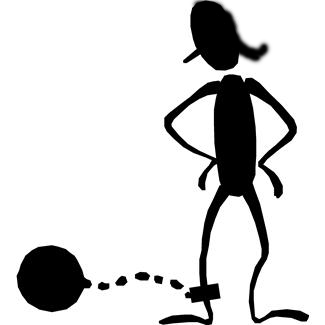
 3) We can remain calm, ask for help if we need it and look at the pros of our new situation. Of course, it’s always good to be balanced and positive. Not always easy and not always sensible. It always pays to stay aware and focused.
3) We can remain calm, ask for help if we need it and look at the pros of our new situation. Of course, it’s always good to be balanced and positive. Not always easy and not always sensible. It always pays to stay aware and focused. Pick 1)(a) or 1)(b) to start.
Pick 1)(a) or 1)(b) to start. Life is full of crossroads. They always show up, in our personal lives and in our lives as global citizens. Every time we make a life decision, we are at a crossroads. Every time we vote, we are at a crossroads. We can look at our choices as necessary steps leading us forward. We can also savor the opportunities they bring and use the pro and con method to ensure that we come to the most efficient understanding of our crossroads as they arrive.
Life is full of crossroads. They always show up, in our personal lives and in our lives as global citizens. Every time we make a life decision, we are at a crossroads. Every time we vote, we are at a crossroads. We can look at our choices as necessary steps leading us forward. We can also savor the opportunities they bring and use the pro and con method to ensure that we come to the most efficient understanding of our crossroads as they arrive. Appetite is a tricky thing. It depends upon the interplay of hormones, insulin, activity, fatigue and our personal control.
Appetite is a tricky thing. It depends upon the interplay of hormones, insulin, activity, fatigue and our personal control. I’ve seen people working on behalf of others where their work has taken away the urge to overeat, the urge to smoke, the urge to drug (although there are physical side effects when we change some habits). Saving Others And Our Planet is phenomenal.
I’ve seen people working on behalf of others where their work has taken away the urge to overeat, the urge to smoke, the urge to drug (although there are physical side effects when we change some habits). Saving Others And Our Planet is phenomenal. Before we look at the ways to get involved, let’s look at the 3 things that change us and, ultimately, change our relationship with our appetite.
Before we look at the ways to get involved, let’s look at the 3 things that change us and, ultimately, change our relationship with our appetite. The secret is that our self-esteem increases as we feel all the fullness and the good feeling from reduced appetite. We are happy to make more of an effort to succeed at our food plan when we look better in our eyes, we feel better from eating less because of the spiritual/emotional fullness and the metabolic boost and we actually are better because of the healthier way we have been living.
The secret is that our self-esteem increases as we feel all the fullness and the good feeling from reduced appetite. We are happy to make more of an effort to succeed at our food plan when we look better in our eyes, we feel better from eating less because of the spiritual/emotional fullness and the metabolic boost and we actually are better because of the healthier way we have been living. We can donate $10 to a charity by mobile phone should we use a major carrier. I learned today that we can even pick a specific micro-loan project and donate once.
We can donate $10 to a charity by mobile phone should we use a major carrier. I learned today that we can even pick a specific micro-loan project and donate once. Donating money is fantastic. It allows us to become bigger than ourselves. The fact that we are doing it regularly connects us to the cause itself.
Donating money is fantastic. It allows us to become bigger than ourselves. The fact that we are doing it regularly connects us to the cause itself. In December 3rd’s article, The Peace Process: A Step-By-Step Formula, we talked about being able to understand conflicting views and really listening to the answers. Action steps were offered which included speaking with the 2 members of opposing geo-politico-religious sides and, by doing so, earning the trust of each.
In December 3rd’s article, The Peace Process: A Step-By-Step Formula, we talked about being able to understand conflicting views and really listening to the answers. Action steps were offered which included speaking with the 2 members of opposing geo-politico-religious sides and, by doing so, earning the trust of each. So Phase 2 has to be about creating a discussion between a neutral person and 2 participants on the same side, with 1 of those agreeing to role play a member of the opposite side: Phase 2 of the Peace Process Formula.
So Phase 2 has to be about creating a discussion between a neutral person and 2 participants on the same side, with 1 of those agreeing to role play a member of the opposite side: Phase 2 of the Peace Process Formula. It is necessary for each side of a conflict to trust the moderator, mediator, arbitrator, counselor.
It is necessary for each side of a conflict to trust the moderator, mediator, arbitrator, counselor.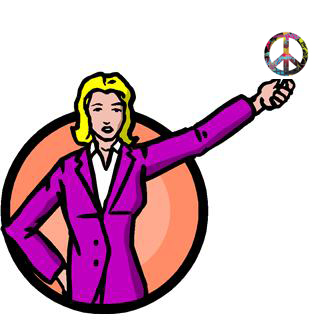


 The peace process is a methodical, step-by-step method that needs simple, focused attention and caring patience. Since we humans can truly focus in on only 1 activity at a time (even though we are a society of multitaskers), when it comes right down to it, when we target our attention in 1 place, it cannot be in another place at that very moment.
The peace process is a methodical, step-by-step method that needs simple, focused attention and caring patience. Since we humans can truly focus in on only 1 activity at a time (even though we are a society of multitaskers), when it comes right down to it, when we target our attention in 1 place, it cannot be in another place at that very moment. In the article, Peace And Prejudice, from June 4 of this year, we talk about how looking at the sameness in human beings can lead us to harmony and tolerance. I have said many times as has Charles Duhigg in his book, The Power Of Habit, that, in order to stop manifesting an old behavior, we have to learn and act out a new one.
In the article, Peace And Prejudice, from June 4 of this year, we talk about how looking at the sameness in human beings can lead us to harmony and tolerance. I have said many times as has Charles Duhigg in his book, The Power Of Habit, that, in order to stop manifesting an old behavior, we have to learn and act out a new one. Another example, that I do not know firsthand, is how quickly we transform from civilian to soldier. One minute, we have a no combat life. The next, we are in a war.
Another example, that I do not know firsthand, is how quickly we transform from civilian to soldier. One minute, we have a no combat life. The next, we are in a war.



 6)
6)



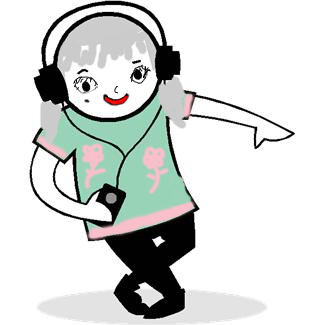
 I remember lunch time when I was in 5th and 6th grades in New York. We had a record player outside in the school yard. Every day, I would bring my 45 RPM records to class so that we could dance. True, there were so many people singing rhythm and blues and rock and roll, so it was much easier to keep track of the latest and greatest records, as opposed to present day when there are hundreds of new artists coming out every minute because of the ease of technology. It’s great to have such technological access!
I remember lunch time when I was in 5th and 6th grades in New York. We had a record player outside in the school yard. Every day, I would bring my 45 RPM records to class so that we could dance. True, there were so many people singing rhythm and blues and rock and roll, so it was much easier to keep track of the latest and greatest records, as opposed to present day when there are hundreds of new artists coming out every minute because of the ease of technology. It’s great to have such technological access!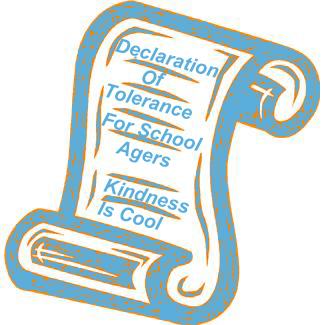 DECLARATION OF TOLERANCE FOR SCHOOL AGERS: KINDNESS IS COOL (ISSUE 53)
DECLARATION OF TOLERANCE FOR SCHOOL AGERS: KINDNESS IS COOL (ISSUE 53)
 We follow others, as kids and adults. We call this social proof. If no one goes to help the person who fell down and everyone walks by with no regard; we are less likely to rush to help the afflicted person.
We follow others, as kids and adults. We call this social proof. If no one goes to help the person who fell down and everyone walks by with no regard; we are less likely to rush to help the afflicted person. Kids form belief systems and opinions at home, in school and with peer groups. It is a given that we are influenced on a grand scale by our parents, our caretakers. Prejudice in the home rubs off. But many kids have their first encounter with intolerance, either as target or aggressor, in school.
Kids form belief systems and opinions at home, in school and with peer groups. It is a given that we are influenced on a grand scale by our parents, our caretakers. Prejudice in the home rubs off. But many kids have their first encounter with intolerance, either as target or aggressor, in school.
 2)
2)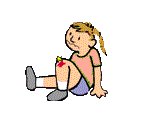 4)
4)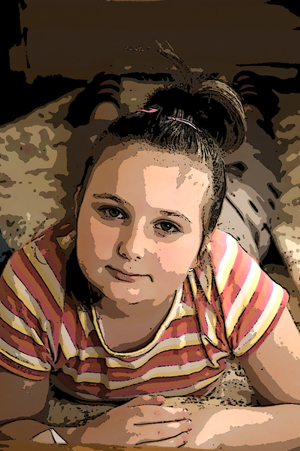 6)
6)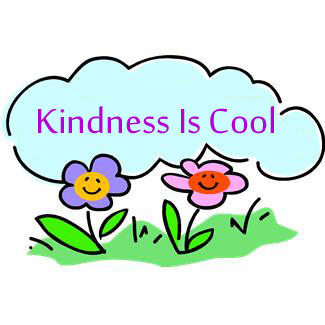 10)
10) 11)
11)





